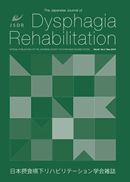Volume 7, Issue 2
The Japanese Journal of Dysphagia Rehabilitation
Displaying 1-7 of 7 articles from this issue
- |<
- <
- 1
- >
- >|
Original Paper
-
2003 Volume 7 Issue 2 Pages 109-116
Published: December 30, 2003
Released on J-STAGE: August 21, 2020
Download PDF (3587K) -
2003 Volume 7 Issue 2 Pages 117-125
Published: December 30, 2003
Released on J-STAGE: August 21, 2020
Download PDF (3959K) -
2003 Volume 7 Issue 2 Pages 126-133
Published: December 30, 2003
Released on J-STAGE: August 21, 2020
Download PDF (3266K) -
2003 Volume 7 Issue 2 Pages 134-142
Published: December 30, 2003
Released on J-STAGE: August 21, 2020
Download PDF (3488K) -
2003 Volume 7 Issue 2 Pages 143-150
Published: December 30, 2003
Released on J-STAGE: August 21, 2020
Download PDF (3399K)
Clinical Report
-
2003 Volume 7 Issue 2 Pages 151-158
Published: December 30, 2003
Released on J-STAGE: August 21, 2020
Download PDF (4084K) -
2003 Volume 7 Issue 2 Pages 159-165
Published: December 30, 2003
Released on J-STAGE: August 21, 2020
Download PDF (3539K)
- |<
- <
- 1
- >
- >|
